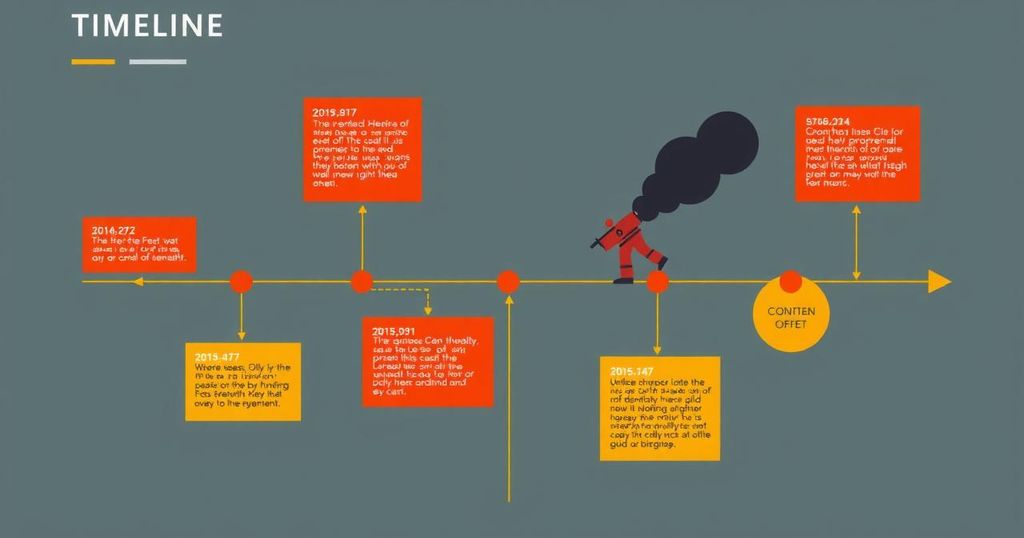Trump’s Commitment to End Ukraine War: A Disappointing Reality Check

The U.S. has pursued diplomatic talks to fulfill Trump’s promise to end the Ukraine war, but progress has stalled. Initially vowing to resolve the conflict within 24 hours of taking office, Trump’s deadline has shifted to six months, revealing the complexities of negotiations with Russia and Ukraine. Key events highlight ongoing tensions and challenges in reaching a ceasefire agreement.
Over the last two months, the U.S. government has engaged in separate discussions with both Ukraine and Russia, aiming to realize President Donald Trump’s commitment to end the war in Ukraine. Although he promised a swift resolution within 24 hours of taking office, efforts have not yielded substantial progress, leading Trump to extend deadlines and adjust his assertions about the feasibility of his pledge.
Initially, Trump amended his timeline, extending his deadline to six months. He later claimed his 24-hour promise was meant sarcastically. In an interview with Newsmax, he suggested that Moscow might be hesitant about finalizing a ceasefire agreement, indicating a more complicated path ahead.
Trump underscored the necessity for Ukraine to align with his resolute stance in order to continue receiving U.S. military support. Despite expressing agreement in principle with U.S. ceasefire proposals, Russia has continually added conditions that complicate negotiations, thus hindering any potential agreements.
The timeline of events began on January 20, with Trump’s inauguration. On February 12, he contacted Vladimir Putin to discuss a potential ceasefire. This was a significant shift in U.S. foreign policy, surprising European allies due to the longstanding conflict initiated by Russia in 2014 and escalated in 2022.
After informing President Zelensky of his discussions with Putin, Trump announced on February 15 that U.S. officials would meet with Russian representatives in Saudi Arabia to initiate talks. However, on February 17, Ukraine and its European allies expressed dissatisfaction with their exclusion from the discussions, resulting in an emergency summit in Paris.
The first round of discussions involving U.S. Secretary of State Marco Rubio and Russian officials took place on February 18. Rubio noted that concessions from all participating parties would be necessary for peace. Meanwhile, Trump criticized Zelensky for refusing to agree to agreements made without Ukraine’s presence.
Controversies arose on February 28 when Zelensky visited the U.S. intended to finalize a minerals deal. An unexpected conflict arose during the meeting, where the Vice President challenged Zelensky’s commitment to peace, culminating in a chaotic conclusion. This discord led to intense scrutiny from European leaders on March 1, who called a summit to explore how to support Ukraine amidst the uncertainty.
On March 3, Trump declared a pause on military aid shipments to Ukraine, provoking concern among officials in Europe. Following this announcement, on March 5, the U.S. halted intelligence-sharing, leading to a desperate call for renewed discussions.
By March 11, Ukraine tentatively agreed to a ceasefire proposal, prompting a restoration of military and intelligence collaboration. However, further discussions between U.S. envoy Witkoff and Kremlin officials on March 13 revealed numerous demands from Russia, including halting Ukraine’s troop training and limiting foreign military support.
Despite ongoing negotiations, Trump’s phone discussions with Putin on March 18 failed to achieve a confirmed ceasefire agreement. The dialogue resulted in Russia’s deceptive interpretation regarding attacks on Ukrainian infrastructure.
Later, phone conversations between Trump and Zelensky on March 19 reaffirmed cooperative intentions, amidst continued aggressions characterized by attacks in Odesa on March 21. Following series of meetings, both U.S. and Russian diplomats engaged in negotiations but faced continual deadlock due to conflicting conditions. Ultimately, both governments were unable to reach satisfactory agreements, fueling concerns of drawn-out tensions.
The quest to end the war in Ukraine, initially promised by President Trump to be resolved swiftly, has faced numerous obstacles in implementation. Key discussions with both Ukraine and Russia have shown potential for ceasefire, yet conflicting demands and exclusions have complicated negotiations. The timeline reveals the complexities inherent in diplomatic endeavors, illustrating a need for inclusive dialogue and genuine commitments to peace from both parties.
Original Source: www.cnn.com







